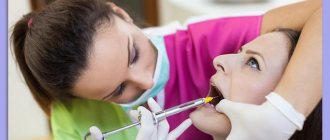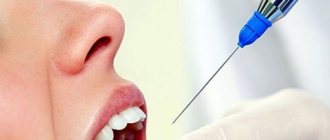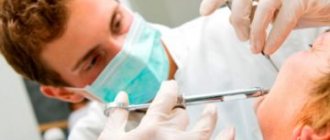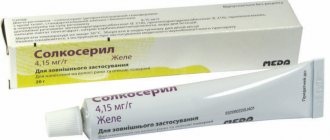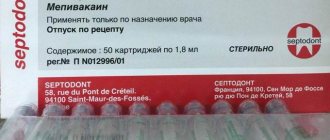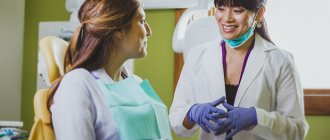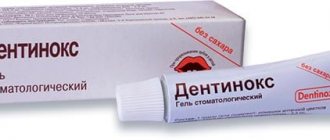What kind of drug is this
“Articaine” (or Articaine in Latin) is a drug for local1 anesthesia, i.e. anesthesia of the area of dental intervention. Used since 1978. Moreover, despite its relative “youth”, it is actively used by dentists - it is highly effective, and is also suitable for children, the elderly, people with chronic diseases, nursing women and expectant mothers.
"Articaine" as an anesthetic is used in dentistry for injections - i.e. pain relief with an injection into the gums or deeper tissues. This drug can also be used for anesthesia in other areas of medicine - in obstetrics, during diagnostic procedures and surgical interventions.
The drug is intended for local anesthesia
On a note! “Articaine” from the domestic variety is a transparent, colorless solution (or yellowish tint). Available in 1.7 ml cartridges, 1, 2, 5, 10 and 20 ml ampoules, 50 ml bottles. Available only by prescription.
Ultracaine D-S forte, 100 pcs., 1.7 ml, 40 mg+10 mcg/ml, solution for injection, with epinephrine
The drug is intended for use in the oral cavity and can only be injected into tissues where there is no inflammation. Do not inject into inflamed tissue.
The drug cannot be administered intravenously.
For anesthesia for uncomplicated extraction of teeth in the upper jaw in the absence of inflammation, it is usually sufficient to create a depot of the drug Ultracain® D-S (Ultracain® D-S forte) in the area of the transitional fold by introducing it into the submucosa from the vestibular side - 1.7 ml of the drug per tooth. In rare cases, an additional injection of 1 ml to 1.7 ml may be required to achieve complete anesthesia. In most cases, this eliminates the need for a painful palatal injection. When removing several adjacent teeth, the number of injections can usually be limited.
For anesthesia for incisions and sutures in the palate in order to create a palatal depot, about 0.1 ml of the drug is required for each injection.
In the case of removal of mandibular premolars in the absence of inflammation, mandibular anesthesia can be dispensed with, because Usually, infiltration anesthesia provided by injection of 1.7 ml of the drug per tooth is sufficient. If in this way it was not possible to achieve the desired effect, an additional injection of 1-1.7 ml of the drug should be performed into the submucosa in the area of the transitional fold of the mandible on the vestibular side. If in this case it was not possible to achieve complete anesthesia, it is necessary to conduct a conduction block of the mandibular nerve.
When treating cavities and grinding teeth for crowns, with the exception of the lower molars, depending on the volume and duration of treatment, it is recommended to administer the drug Ultracain® D-S with a lower content of epinephrine into the area of the transitional fold on the vestibular side in a dose of 0.5-1.7 ml per tooth.
When performing one treatment procedure, adults can be administered articaine in a dose of up to 7 mg per 1 kg of body weight. It was noted that patients tolerated doses up to 500 mg (corresponding to 12.5 ml of solution for injection) well.
In children over 4 years of age, the dose of the drug is selected depending on the age and body weight of the child; the dose should not exceed 5 mg of articaine per 1 kg of body weight.
In elderly patients and patients with severe renal and hepatic impairment, increased plasma concentrations of articaine may occur. In these patients, the drug should be used in the minimum dose necessary to achieve a sufficient depth of anesthesia.
In order to avoid accidental intravascular administration of the drug, an aspiration test should always be performed before its administration.
The injection pressure should correspond to the sensitivity of the tissue.
Composition and features of action
The drug contains an active substance with a local anesthetic effect - articaine hydrochloride (20 mg or 40 mg). Additional components are sterilized water (up to 1 ml) and sodium chloride (7 mg). Thus, it turns out that the concentration of articaine hydrochloride is only 4 percent. But for local anesthesia in dentistry, this amount is quite enough to numb the tooth or jaw.
The pharmacological properties of Articaine consist in blocking nerve impulses in the injection area. Those. the nerve endings seem to “freeze”, the injection area becomes numb and loses sensitivity. What are the advantages of the anesthetic? The substance “works” only at the injection site in the oral cavity and does not have a vasoconstrictor or toxic effect on the body as a whole (i.e. other organs). When the effect of the injection ends, the sensitivity and conductivity of impulses is completely restored.
There are 3 known types of the drug in dentistry
Release form, packaging and composition of the drug Articaine-Binergia with adrenaline
Injection
transparent, colorless or with a yellowish tint.
| 1 ml | |
| articaine hydrochloride | 10 mg |
| epinephrine | 0.05 mg |
Excipients
: sodium disulfite - 0.5 mg, sodium chloride - 7 mg, disodium edetate - 0.25 mg, sodium hydroxide solution 1M to pH 5.0, water for up to 1 ml.
5 ml - colorless glass ampoules (5) - contour cell packaging (1) - cardboard packs. 5 ml - colorless glass ampoules (5) - contour cell packaging (2) - cardboard packs. 10 ml - colorless glass ampoules (5) - contour cell packaging (1) - cardboard packs. 10 ml - colorless glass bottles (5) - contour cell packaging (1) - cardboard packs. 20 ml - colorless glass ampoules (5) - contour cell packaging (1) - cardboard packs.
Injection
transparent, colorless or with a yellowish tint.
| 1 ml | |
| articaine hydrochloride | 20 mg |
| epinephrine | 0.05 mg |
Excipients
: sodium disulfite - 0.5 mg, sodium chloride - 5.2 mg, disodium edetate - 0.25 mg, sodium hydroxide solution 1M to pH 5.0, water for up to 1 ml.
5 ml - colorless glass ampoules (5) - contour cell packaging (1) - cardboard packs. 5 ml - colorless glass ampoules (5) - contour cell packaging (2) - cardboard packs. 10 ml - colorless glass ampoules (5) - contour cell packaging (1) - cardboard packs. 10 ml - colorless glass bottles (5) - contour cell packaging (1) - cardboard packs. 20 ml - colorless glass ampoules (5) - contour cell packaging (1) - cardboard packs.
Types of the drug and duration of action
There are 3 known varieties of the drug in dentistry - the first is “Articaine” without adrenaline/epinephrine (with a minimum of contraindications). Actually, when they talk about “Articaine”, they mean the variety without adrenaline. Also produced are “Articaine” with adrenaline 0.005 mg/ml and a modification “Forte” with adrenaline 0.01 mg/ml. The local anesthetic effect is clearly evident within 1-11 minutes after the injection.
How long does each anesthetic last? The pronounced effect of “Articaine” without adrenaline is observed for 20 minutes or longer, with adrenaline (depending on its concentration) from 45 to 75 minutes. Taking into account the dose, body weight and metabolic rate, the anesthetic effect can last from 1 to 4 hours, i.e. within 4 hours, sensitivity is completely restored.
pharmachologic effect
The combined drug has a local anesthetic effect.
Artikain
- local anesthetic of the amide type of a number of thiaphenes. The mechanism of action is due to the stabilization of neuronal membranes and the prevention of the occurrence and conduction of a nerve impulse.
Epinephrine
- adrenergic agonist. Causes vasoconstriction at the injection site, which complicates the absorption of articaine and prolongs the effect of the local anesthetic effect. The onset of the effect is 0.5-3 minutes, the duration of action is 45 minutes.
When is an anesthetic used and who is it allowed for?
"Articaine" is used for infiltration (injection near the tooth) and conduction (blocking a large nerve trunk) anesthesia. Indications for use in dentistry are as follows:
- dental treatment (therapeutic dentistry): deep caries, medium caries - treated with anesthesia less often, mainly if there is increased sensitivity or a low pain threshold. Various pulpitis and periodontitis are also treated with local anesthesia,
- surgical dentistry: "Articaine" is used for tooth extraction - simple and complex, for gum plastic surgery, removal of hard deposits (stones) from under the gums, root resection, installation of implants, maxillofacial operations,
- prosthetics (orthopedic dentistry): preparing teeth for prosthetics - turning for veneers and crowns, removing the dental nerve, filling root canals, installing fasteners for removable dentures on teeth, gum retraction (if necessary, pain relief).
The drug can be used in dental treatment
Use with caution - in pregnant women, children and patients at risk
“Articaine” without adrenaline is allowed in dentistry during pregnancy (since it does not reduce blood supply to the uterus), children over 4 years old, as well as patients over 65 years old, people with liver and kidney diseases. But in any of the above situations, the drug is used with caution. And if an anesthetic is used for the first time in life, the dentist first administers a “microdose” to rule out allergies.
The product should be used with caution during pregnancy
Good to know! During lactation (breastfeeding), you can use this anesthetic and continue to feed the baby as usual - without pumping and temporary transfer to artificial formula. Studies have shown that articaine is slightly excreted in breast milk and does not harm the baby.
Contraindications for use
B12 deficiency anemia; methemoglobinemia; paroxysmal ventricular tachycardia; atrial fibrillation; angle-closure glaucoma; hypoxia; intolerance to sulfo groups (especially in bronchial asthma); hypersensitivity to the components of the combination.
Carefully:
cholinesterase deficiency, renal failure, bronchial asthma, diabetes mellitus, hyperthyroidism, arterial hypertension, children's age (up to 4 years - effectiveness and safety have not been determined).
When performing paracerebral blockade:
preeclampsia, bleeding in the third trimester of pregnancy, amnionitis.
What contraindications exist
Any anesthetic drug has contraindications - some have more, some have less. If you refer to the instructions for use in dentistry, then “Articaine” without adrenaline has the following contraindications:
- inflammation of the tissue at the site of the planned needle puncture,
- neoplasms,
- polio,
- meningitis,
- hemorrhage in the cranial cavity,
- cardiovascular pathologies in the acute stage or immediately after it,
- significantly reduced blood pressure,
- poor blood clotting,
- allergy to this anesthetic.
Before using the drug, you should find out about contraindications. Contraindications
for the use in dentistry of “Articaine with adrenaline” and “Articaine with adrenaline forte” are a severe form of hypertension, tachycardia, and a recent heart attack. During lactation or pregnancy, the dose of adrenaline should not be higher than 0.005 mg/ml, but it is better to use a local anesthetic without it.
Directions for use and doses
In accordance with the instructions for use of the drug in dentistry, “Articaine” without or with adrenaline is prescribed in a dosage of 1.7 ml - for the treatment of 1 tooth or two adjacent teeth. If necessary, you can give another injection with a volume of 1-1.7 ml. In general, the maximum single dose of Articaine for adults is 6-7 mg/kg. For example, the maximum permissible dose for an adult weighing 70 kg would be 420 mg of articaine. Those. You can give up to 10 doses of the drug, 1 ml each, one time (or up to 6 injections, 1.7 ml each). For children, the maximum dose is 5 mg of the drug per 1 kg of body weight.
The drug is injected into the gum, periosteum, pulp (dental nerve), and ligament of the tooth (the periodontium is the layer connecting the root and the bone socket) using a special carpule syringe - with infiltration anesthesia, and in close proximity to a large nerve - with conduction anesthesia. The injection site is first disinfected with an antiseptic.
Instructions for use ARTICAINE + EPINEPHRINE
The drug is recommended for use in dentistry. Cannot be used to treat children under 4 years of age. The smallest amount of medication that will provide effective pain relief should be used.
Adults:
when removing upper teeth, in most cases 1.7 ml of the drug per tooth is sufficient;
- In most cases, there is no need to perform painful palatal injections. In cases of alternate removal of adjacent teeth, it is possible to reduce the number and volume of injections. If it is necessary to make an incision or suture in the palate, a palatal injection is indicated at the rate of 0.1 ml for each puncture. To remove premolars of the lower jaw, in most cases, infiltration anesthesia in a volume of 1.7 ml of the drug per tooth is sufficient;
- in some cases, repeated buccal injection in a volume of 1 to 1.7 ml is required. In rare cases, a mandibular nerve block may be indicated. To prepare a tooth cavity or tooth stump for a crown, drug injections are used in volumes of 0.5 to 1.7 ml per tooth.
When treating mandibular molars, a nerve block technique should be used. In surgery, the volume of the drug is selected individually depending on the severity and duration of the operation and the individual characteristics of the patient.
In elderly patients
Due to weakened metabolic processes and a lower volume of distribution, increased plasma levels of the drug may be observed. The risk of drug accumulation increases after repeated applications (eg, repeat injections). For this reason, for older people, as well as for adults with heart and liver diseases, it is recommended to use the drug in lower dosages compared to those recommended for adult patients (the minimum amount for a sufficient depth of pain relief).
In patients with liver failure
the active substance of the drug (Articaine) is metabolized in the liver. Due to its long duration of action and systemic accumulation, the anesthetic should be used in lower doses for patients with impaired liver function.
In patients with renal failure
Articaine and its metabolites are mainly excreted in the urine. Due to the long duration of action and systemic accumulation, lower doses of the anesthetic should be used in patients with severe renal impairment.
In patients with special genotypic characteristics:
in patients suffering from congenital or acquired deficiency of plasma cholinesterase activity, the use of the drug is contraindicated.
Other special populations:
patients with certain diseases (angina pectoris, atherosclerosis), as well as in patients who are simultaneously taking medications that may interact with aticaine and/or epinephrine, the dose is also reduced. For patients belonging to special groups, it is recommended to use a minimum amount of the drug to achieve a sufficient depth of anesthesia.
Children and teenagers:
The amount of drug to be administered is determined by the age and body weight of the patient and the extent of the surgical procedure.
Children over 4 years old and adolescents aged 13-18 years:
| Body weight, kg | Recommended dosage | |
| Articaine/mg/child | HP/ml/child | |
| 20 — <30 | 10-40 | 0.25 ml - 1 ml |
| 30 — <40 | 20-80 | 0.5 ml - 2 ml |
| 40 — <45 | ||
Since articaine is quickly distributed in tissues, and bone density in children is lower than in adults, conduction anesthesia can be used in children and adolescents instead of infiltration.
Children under 4 years old:
the drug is contraindicated in children under 4 years of age, as safety and effectiveness have not been established.
Maximum recommended dose:
- For adults:
for healthy adult patients, the maximum dose is 7 mg articaine per kg body weight (500 mg for a 70 kg patient), equivalent to 12.5 ml of drug. The maximum dose is 0.175 ml of solution per 1 kg.
For children:
The amount to be injected should be determined based on the age and weight of the child and the extent of the operation. Do not exceed the equivalent of 7 mg articaine per kg body weight (0.175 ml drug/kg).
| Body weight (kg) (respective age groups ± within the height chart) | Maximum permissible dose (equivalent to 7 mg/kg body weight) | |
| Articaine mg/child | HP/ml/child | |
| 20 — <30 | 140 | 3.5 |
| 30 — <40 | 210 | 5.25 |
| 40 — <45 | 280 | 7.0 |
| 45 — <50 | 315 | 7.9 |
| 50 — <60 | 350 | 8.7 |
| 60 — <70 | 420 | 10.5 |
| 70 — <80 | 490 | 2.12 |
All the above dosages are typical for Articaine + Epinephrine (40 mg/0.01 mg)/ml and (40 mg/0.005 mg)/ml. Articaine + Epinephrine (40 mg/0.005 mg)/ml is more suitable for routine operations and/or treatments in which stopping bleeding is of secondary importance.
For use in dental anesthesia only!
To avoid intravascular injection, careful aspiration control should always be ensured in at least two planes (rotating the needle 180°), although a negative aspiration result does not guarantee the complete exclusion of involuntary and undetected intravascular injection. The injection rate should not exceed 0.5 ml for 15 seconds, that is, 1 cartridge per minute.
In most cases, serious general reactions of the body as a result of accidental intravascular injection can be avoided by the following injection technique - after aspiration, slowly inject 0.1-0.2 ml of the drug, and use the rest no earlier than 20-30 seconds later.
Opened cartridges should not be used on other patients. Residues must be disposed of.
What side effects may there be?
Side effects are present with any local anesthetic - both in dentistry and in any other field of medicine. The most common side effects of Articaine (occur in 1-2 out of 100 patients) look like this:
- sensation of “pins and needles”, burning, tingling in the area where the anesthetic was administered,
- decreased sensitivity to external stimuli,
- headache,
- nausea and vomiting.
After use, nausea and vomiting may appear.
Less common side effects of Articaine are dizziness, nervousness, respiratory distress, swelling and inflammation of the gums, itching, redness, convulsions, visual or hearing disturbances, slow heartbeat, decreased blood pressure, anaphylactic shock, etc. d. If the needle is inserted incorrectly, injury to the facial nerve, including paralysis, is possible.
“During pregnancy, I had my teeth treated with an injection of articaine, it wasn’t painful or scary. And then with him too, because he works well for me. Then the head is not “cast iron”. But my sister didn’t feel well during the treatment; her heart was pounding frequently and she felt feverish. But she already has some minor problems with her heart. Maybe because of this."
Anastasia, review from otzovik.com
Side effect
From the side of the central nervous system
(depending on the dose applied): headache, impaired consciousness (up to loss of consciousness);
breathing disorders (up to apnea); tremor, muscle twitching, convulsions. From the digestive system:
nausea, vomiting, diarrhea.
From the senses:
rarely - transient visual impairment (up to blindness), diplopia.
From the cardiovascular system:
decreased blood pressure, tachycardia, bradycardia, arrhythmia.
Allergic reactions:
hyperemia and itching of the skin, conjunctivitis, rhinitis, angioedema of varying severity (including swelling of the upper and/or lower lip and/or cheeks, glottis with difficulty swallowing, urticaria, difficulty breathing), anaphylactic shock.
Local reactions:
swelling or inflammation at the injection site, the appearance of ischemic zones at the injection site (up to the development of tissue necrosis - in case of accidental intravascular injection); nerve damage (up to the development of paralysis) - occurs only when the injection technique is violated.
Consequences of drug overdose
In case of an overdose, the likelihood of “side effects” sharply increases, or one of them becomes very pronounced. The greatest danger is an overdose of adrenaline - if it is included in the drug. Symptoms of overdose when the central nervous system is depressed or excited are the following:
- fast or slow heartbeat,
- rapid breathing, shortness of breath, respiratory arrest,
- decrease or increase in blood pressure,
- “blueness” of the skin (cyanosis),
- cardiac arrest, death.
Therefore, Articaine can only be used by a professional dentist who knows the complete instructions for use - methods of administration and dosage for each patient.
Interactions with other medications
As for the interaction of the anesthetic drug with other drugs, combination with such drugs as:
- simultaneous use of anesthetics with antidepressants: since this combination can sharply reduce blood pressure,
- with non-narcotic analgesics (“Analgin”, “Paracetamol”, etc.): there is a risk of respiratory depression,
- with drugs that reduce blood clotting (anticoagulants): the risk of bleeding increases,
- with vasoconstrictors: enhance the effect and prolong the duration of action of the anesthetic.
It is not recommended to combine an anesthetic with certain drugs
Anesthetics similar in composition
A complete analogue of “Articaine” in dentistry is the drug “Ultracaine D”. Produced in Germany by a large pharmaceutical company (Sanofi-Aventis, France). It has fewer contraindications than the domestic product and is better tolerated by patients. If we consider analogs that contain adrenaline, then we can use o (France) and “Ubistezin” (Palestine).
The product is completely free of stabilizing preservatives
Cost of injection with anesthetic
The cost of pain relief during dental surgery depends on the dose and number of injections (sometimes the anesthetic is injected during the process). The price of 1 injection of Articaine starts at 250 rubles in public clinics. But in private dentistry, the cost may be higher, or may be immediately included in the general price list - if, for example, caries is treated on a turnkey basis. Here the price is already fixed, i.e. even if you have to finish the drug, you don’t need to pay extra for it.
1Rabinovich S.A. Means and methods of local anesthesia in dentistry, 2013.
special instructions
Do not administer IV! To avoid intravascular injection, an aspiration test must be performed. The injection pressure must correspond to the sensitivity of the tissue. You cannot inject into the inflamed area. Eating is possible only after sensitivity has been restored. Impact on the ability to drive vehicles and machinery
The possibility of allowing the patient to drive vehicles or engage in activities requiring high mental and motor reactions is determined by the doctor.
